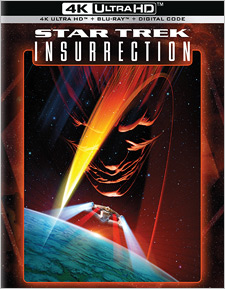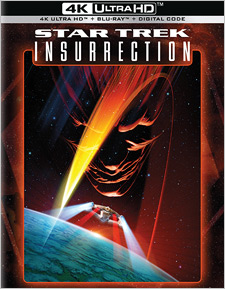Star Trek: Insurrection (4K UHD Review)

Director
Jonathan FrakesRelease Date(s)
1998 (April 4, 2023)Studio(s)
Paramount Pictures (Paramount Home Entertainment)- Film/Program Grade: C
- Video Grade: A
- Audio Grade: B+
- Extras Grade: B-
Review
[Editor’s Note: This title is also included in Paramount’s Star Trek: The Next Generation 4-Movie Collection box set.]
Smack in the middle of the Federation, there’s a dangerous region of space called the Briar Patch. And smack in the middle of the Briar Patch is a little gem of a world—green, lush, and temperate—where the inhabitants never grow old. It seems the planet’s rings give off a strange radiation that rejuvenates living cellular tissue, making the place a sort of fountain of youth. On this world is a race called the Ba’ku, who’ve given up technology to live in harmony with nature. Of course, there’s another race—the dying and nasty Son’a—that desperately wants to harness this radiation to save themselves, even though their plan for doing so will render the planet inhospitable.
But the Son’a will happily share this technology with the Federation, so Starfleet Admiral Dougherty has made a deal with the devil and is about to break the Prime Directive by relocating the Ba’ku without their knowledge. Fortunately, Commander Data has been helping to study the Ba’ku. When he stumbles upon this plan, our favorite android gets shot and goes nuts, causing Dougherty to call Captain Jean-Luc Picard to ask for the plans to deactivate him. Naturally suspicious, Picard and the Enterprise-E crew take it upon themselves to investigate, quickly realize what’s happening, and must race to stop the Son’a and get word to the Federation before it’s too late.
Critics were not kind to Star Trek: Insurrection upon its release, and somewhat unjustly. No, the film isn’t loaded with action, and no, there aren’t any Klingons, Romulans, or Borg. This is a story about ideals, in which the characters examine their own principles and are forced to make a choice—betray Starfleet or the very beliefs they hold most sacred. Before you get too excited however, there’s still plenty to cringe about. The problem here isn’t second-time director Jonathan Frakes, it’s that the ratio of drama to sap is out of balance. Sure, there are fun character moments for longtime fans of Star Trek: The Next Generation, but much of it will bore anyone else in a hurry. The necessity of Worf coping with Klingon zits, for example, or Troi and Crusher talking about how their boobs are firming up, is debatable. And the film’s best asset, actor F. Murray Abraham (Amadeus) as the Son’a commander, is lost under a mountain of make-up and prosthetics, though Donna Murphy is undeniably compelling as a Ba’ku leader and Picard’s romantic interest.
Star Trek: Insurrection was shot by cinematographer Matthew F. Leonetti (Poltergeist, Star Trek: First Contact) on 35 mm photochemical film using Panavision Panaflex Gold II cameras with Panavision Primo and C-Series anamorphic lenses. Visual effects were completed using a combination of practical and digital models (though the space-based effects were all CG this time around, produced by SBS—while Blue Sky did the planet-based shots—instead of ILM), and the film was finished photochemically at the 2.39:1 “scope” ratio for theaters. For its debut on Ultra HD, Paramount has completed a new 4K scan of the original camera negative and master interpositive elements to produce a new 4K Digital Intermediate, complete with color grading for High Dynamic Range (both HDR10 and Dolby Vision options are available). Not unlike First Contact in 4K (reviewed here), the resulting image offers a significant image upgrade over the 2009 Blu-ray release, which was rife with digital processing and excessive grain reduction. There’s a major uptick in resolution and detail in live actions shots, with greater refinement in texturing too, visible in skin, uniform fabrics, and foliage once the action (such as it is) moves outdoors to the planet’s surface. Contrast is improved a bit too, though the image is never quite as bold looking as it appeared in the previous film in 4K. Shadows are a little less dark, and highlights are a little more restrained. Colors are pleasingly saturated, however, and exhibit much greater nuance and accuracy than they did in HD on Blu-ray. The dense nebulosity of the Briar Patch impresses in particular, as do computer displays, foliage, and the film’s mountain lake setting. Photochemical grain is light but natural all times. The overall 4K image here is certainly lovely and technically impressive, it’s just not quite as dramatic and pleasingly cinematic it was in the previous installment.
[Editor’s Note: For years, a belief has persisted that the Son’a collector scene in this film was essentially an unfinished visual effect, as the backdrop of the set looks like bluescreen material. In fact, Star Trek production veteran Michael Okuda—who served as the film’s scenic art supervisor—has weighed in on Twitter recently to tell the actual behind-the-scenes story. You can read the relevant exchange below, in the additional notes at the end of this review. Hopefully, this resolves any confusion on the topic. Also, some viewers have noticed that the image appears to be slightly squeezed in a few shots. This is related to the choice of lenses used and how those choices were handled in post-production. The issue has been present in the film since its initial theatrical release, and neither Paramount nor producer Rick Berman feels that it worthy of correcting. Just FYI.]
Primary audio on both Paramount’s 4K Ultra HD and remastered Blu-ray is included in English 7.1 surround in lossless Dolby TrueHD format, essentially the same track found on the 2009 Blu-ray (though with subtle adjustments, as the BDs were 5.1 only). While not a new Atmos mix, the TrueHD provides a satisfying surround experience. The stage is medium-wide and immersive, with good use of the rear channels for music and environmental effects. The dynamic range is pleasing, as are the clarity, tonal quality, and bass, but the film only occasionally flexes its muscles. Jerry Goldsmith’s restrained score sounds lovely though. All in all, it’s a good sonic experience. Additional audio options include English Audio Description, German 5.1 Dolby TrueHD (German 5.1 Dolby Digital on the Blu-ray) and Spanish, French, and Japanese 5.1 Dolby Digital. Subtitles on both the Blu-ray and 4K are available in English, English for the Hearing Impaired, Danish, German, Spanish, French, Japanese, Dutch, Norwegian, Finnish, and Swedish. There are also subtitles for the commentary tracks (including the text commentary) in English, German, Spanish, French, and Japanese.
Paramount’s new 4K UHD release is a 2-disc set (UHD and Blu-ray). Each disc offers a simple menu interface featuring the theatrical poster artwork for the film. The 4K disc includes the following special features:
- Audio Commentary by Jonathan Frakes and Marina Sirtis
- Text Commentary by Michael and Denise Okuda
The commentary with Frakes and Marina Sirtis was recorded for the 2009 Blu-ray release, while the Okuda text commentary appeared on the 2005 DVD. Frakes and Sirtis are surprisingly enjoyable to listen to; the pair are obviously old friends and have lovely chemistry together. They mostly just watch the film and talk about what they’re seeing, but they’re genuinely funny. The text commentary, of course, delievers a steady stream of trivia and other detail.
Insurrection is offered in remastered 1080p HD on a Blu-ray in this package as well (and this disc is also available separately). It includes the following additional special features:
- Audio Commentary by Jonathan Frakes and Marina Sirtis
- Text Commentary by Michael and Denise Okuda
- Library Computer Viewing Mode (HD)
- Production
- It Takes a Village (SD – 16:41)
- Location, Location, Location (SD – 19:56)
- The Art of Insurrection (SD – 14:53)
- Anatomy of a Stunt (SD – 6:33)
- The Story (SD – 17:19)
- Making Star Trek: Insurrection (SD – 25:07)
- Director’s Notebook (SD – 18:56)
- The Star Trek Universe
- Westmore’s Aliens (SD – 17:43)
- Westmore’s Legacy (SD – 12:45)
- Star Trek’s Beautiful Alien Women (SD – 12:40)
- Marina Sirtis: The Counselor Is In (HD – 8:26)
- Brent Spiner: Data and Beyond – Part Three (HD – 8:17)
- Trek Roundtable: Insurrection (HD – 10:50)
- Starfleet Academy SCISEC Brief 009: The Origins of the Ba’ku and Son’a Conflict (HD – 3:00)
- Creating the Illusion
- Shuttle Chase (SD – 9:36)
- Drones (SD – 4:43)
- Duck Blind (SD – 4:38)
- Deleted Scenes
- Peter Lauritson Introduction (SD – :22)
- Ru’afo’s Facelift (SD – :47)
- Working Lunch (SD – 1:37)
- Flirting (SD – 2:20)
- The Kiss (SD – 1:45)
- Status: Precarious (SD – :32)
- Disabling the Injector (SD – 1:34)
- Alternate Ending (SD – 3:53)
- Archives
- Storyboards: Secondary Protocols (HD)
- Photo Gallery (HD)
- Easter Egg: Worf and Troi (SD – 1:58)
- Easter Egg: Tom Morello (SD – 2:17)
- Easter Egg: Marina/Craft Services (SD – 2:02)
- Advertising
- Teaser Trailer (HD – 1:46)
- Theatrical Trailer (HD – 2:25)
- Original Promotional Featurette (SD – 5:02)
- Borg Invasion Trailer (SD – :32)
Most of these features were produced for the 2005 Collector’s Edition DVD, while the rest was added for the 2009 Star Trek: The Next Generation Movie Collection Blu-ray box set. Nothing new is included, but fans will be pleased to know that everything from those previous discs carries over here—even the trio of Easter eggs hidden in the DVD’s menus. There are featurettes on various aspects of the film’s design and production, a good Director’s Notebook, a look back at the alien creature and make-up work of Michael Westmore, a look at Sirtis’ Counselor Troi character, and another piece with Brent Spiner. You also get several deleted scenes and an alternate ending. A Digital Copy code on a paper insert completes the supplements.
The biggest problem with The Next Generation feature films is that too often the writers and producers—having grown comfortable with working on a TV show for seven seasons—simply continued to make TV stories for the big screen. For example, while The Measure of a Man is one of Trek’s best episodes, it would make a terrible film. Likewise, Star Trek: Insurrection just feels small, with few memorable moments or set-pieces, and no iconic characters or dialogue. There’s really nothing about its story that couldn’t have been told just as well in a two-part TV episode. But hey... at least the film has never looked better than it does here in remastered 4K from Paramount. The disc is recommended, but for diehard fans only.
[Editor’s Note: Whether you’re ultimately a fan of this film’s story or not, the late screenwriter Michael Piller’s unpublished FADE IN book about the making of this film is a gem and well worth reading. You can find it here.]
- Bill Hunt
(You can follow Bill on social media at these links: Twitter and Facebook)
Additional Notes
Here’s Star Trek production veteran Michael Okuda—who served as this film’s scenic art supervisor—with the behind-the-scenes story of the blue set background in the Son’a collector scene. The original Twitter comment is linked here:
“In fact, the blue screens were intended to be blue. Lighting a blue screen for visual effects, especially in that era, was an extremely exacting process, necessary to achieve an even brightness across the entire screen’s surface. This was not done for the collector backgrounds. Also, the collector set was added to the script rather late in the preproduction process. Writer Michael Piller asked me for suggestions for a setting where they could add a dramatic fight. I suggested the scaffolding behind the big ‘blue sky’ backdrop on the Paramount backlot, knowing that the film’s budget was already spoken for, so any new addition would need to be very economical. Nevertheless, Piller and production designer Herman Zimmerman were able to convince the studio to fund an enormous new set.”
- Mike Okuda via Twitter, February 8, 2023

